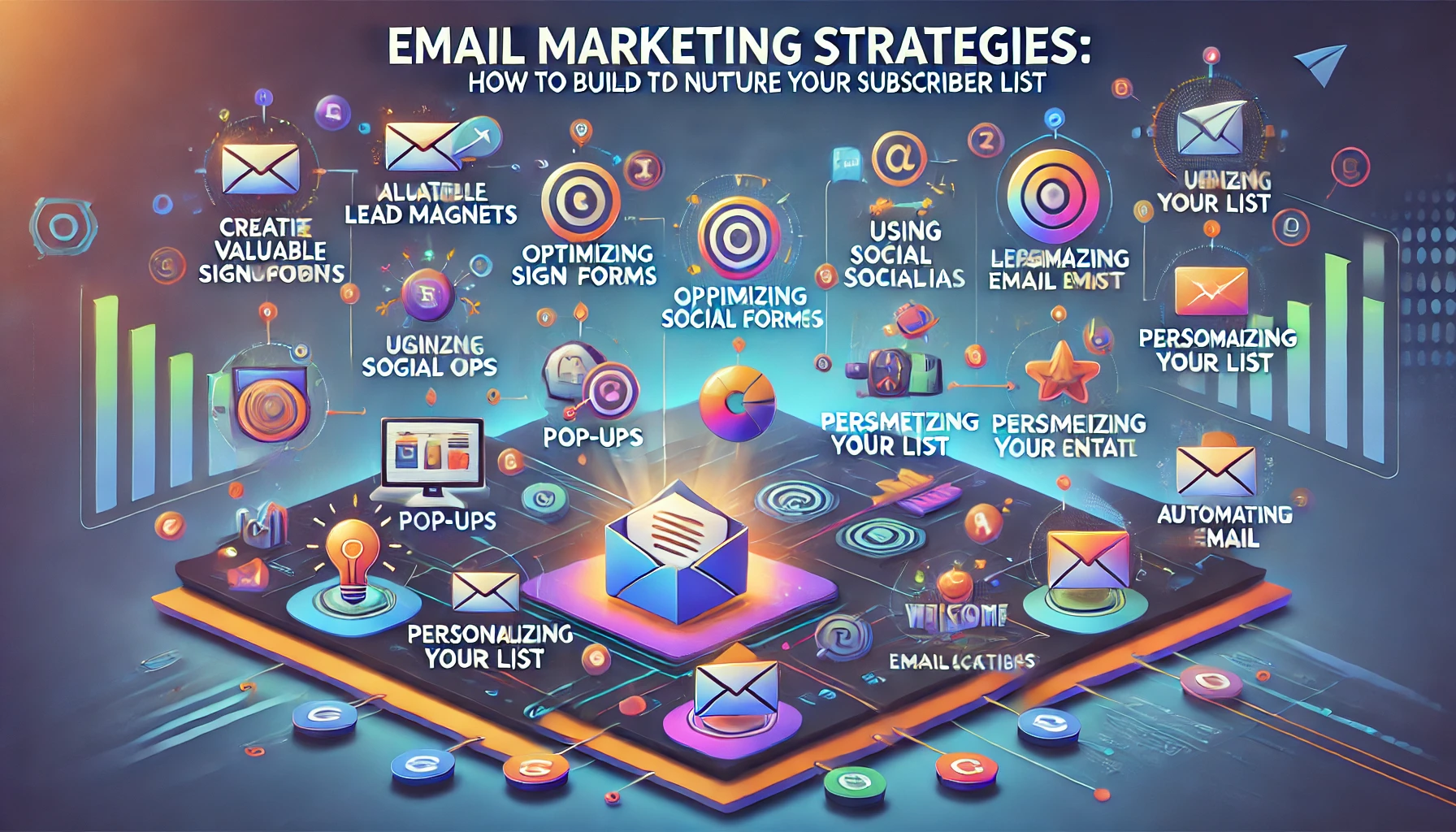Email Marketing Strategies: How to Build and Nurture Your Subscriber List
Building and nurturing your subscriber list is crucial for successful email marketing. By focusing on building, nurturing, and your subscriber list, you can create meaningful relationships and drive conversions. In this comprehensive guide, we will explore effective email marketing strategies to help you grow and engage your subscriber list.
Building Your Subscriber List: The Foundation of Email Marketing
To maximize the impact of your email marketing efforts, you need to build a robust subscriber list. Here are essential strategies for growing your list:
- Create Valuable Lead Magnets: Offer free resources such as ebooks, whitepapers, checklists, or templates in exchange for email addresses. Ensure your lead magnets provide real value to your target audience.
- Optimize Signup Forms: Place signup forms prominently on your website, blog, and social media channels. Use compelling calls-to-action (CTAs) to encourage signups.
- Use Pop-Ups and Slide-Ins: Implement exit-intent pop-ups and slide-ins to capture visitors’ attention before they leave your site. Offer incentives like discounts or free trials to entice signups.
- Leverage Social Media: Promote your email list on social media platforms. Use engaging posts and stories to highlight the benefits of subscribing.
- Run Contests and Giveaways: Host contests and giveaways that require participants to subscribe to your email list. This can quickly boost your subscriber count.
Nurturing Your Subscriber List: Building Relationships
Nurturing your subscriber list involves building relationships and providing value to keep your audience engaged. Here’s how to do it effectively:
- Welcome Emails: Send a welcome email to new subscribers to introduce your brand and set expectations. Include a special offer or valuable content to make a positive first impression.
- Segmentation: Segment your email list based on demographics, interests, and behaviors. This allows you to send targeted and relevant content to different groups of subscribers.
- Personalization: Personalize your emails by using subscribers’ names and tailoring content to their preferences. Personalized emails have higher open and click-through rates.
- Consistent Communication: Maintain regular communication with your subscribers. Send emails consistently, whether it’s weekly, bi-weekly, or monthly, to keep your audience engaged.
- Value-Driven Content: Provide valuable content that addresses your subscribers’ pain points and interests. This can include educational articles, how-to guides, industry news, and exclusive offers.
Crafting Compelling Email Content
Creating compelling email content is essential for engaging your subscribers and driving conversions. Focus on delivering value and making your emails visually appealing.
- Strong Subject Lines: Craft attention-grabbing subject lines that entice recipients to open your emails. Keep them concise and relevant to the content inside.
- Engaging Preheader Text: Use preheader text to provide a preview of your email content. This text appears next to the subject line and can influence open rates.
- Clear and Compelling CTAs: Include clear and compelling calls-to-action in your emails. Encourage recipients to take specific actions, such as downloading a resource, registering for a webinar, or making a purchase.
- Visual Elements: Enhance your emails with images, videos, and graphics. Visual elements can make your emails more engaging and easier to read.
- Mobile Optimization: Ensure your emails are mobile-friendly. A significant portion of email opens occur on mobile devices, so your emails should be easy to read and navigate on smaller screens.
To stay updated on the latest email marketing trends and best practices, visit Mailchimp’s Email Marketing Blog.
Automating Your Email Marketing
Email automation can save time and increase the effectiveness of your campaigns. Use automation to deliver timely and relevant content to your subscribers.
- Welcome Series: Set up a series of welcome emails to introduce new subscribers to your brand and guide them through their initial interactions.
- Drip Campaigns: Create drip campaigns to nurture leads over time. Send a sequence of emails that provide valuable information and gradually move subscribers toward conversion.
- Behavioral Triggers: Use behavioral triggers to send automated emails based on subscribers’ actions, such as abandoned cart reminders, product recommendations, or re-engagement emails.
- Re-Engagement Campaigns: Identify inactive subscribers and use re-engagement campaigns to win them back. Offer incentives or exclusive content to encourage them to re-engage.
Measuring and Analyzing Performance
Regularly measuring and analyzing your email marketing performance is crucial for optimizing your strategy and achieving better results.
- Track Key Metrics: Monitor key metrics such as open rates, click-through rates, conversion rates, and unsubscribe rates to gauge your email performance.
- A/B Testing: Conduct A/B tests to compare different elements of your emails, such as subject lines, content, and CTAs. Use the results to optimize your future campaigns.
- Analyze Subscriber Behavior: Use analytics tools to understand how subscribers interact with your emails. Identify patterns and trends to refine your strategy.
- Feedback and Surveys: Collect feedback from your subscribers through surveys and polls. Use their input to improve your content and delivery.
By following these email marketing strategies, you can effectively build and nurture your subscriber list. Focus on providing value, personalizing your content, and maintaining consistent communication to engage your audience. Utilize automation to streamline your efforts and measure performance to continually optimize your strategy. Embrace the power of email marketing to build strong relationships, drive conversions, and achieve your business goals.
To read more articles like this, visit: Regent Studies




